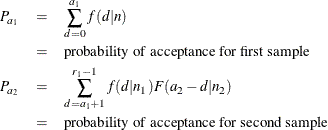Functions
computes the acceptance probability for a double-sampling plan.
PROBACC2![]()
PROBACC2![]()
where
|
|
is the acceptance number for the first sample, where |
|
|
is the rejection number for the first sample, where |
|
|
is the acceptance number for the second sample, where |
|
|
is the size of the first sample, where |
|
|
is the size of the second sample, where |
|
D |
is the number of nonconforming items in the lot, where |
|
N |
is the lot size, where |
|
p |
is the proportion of nonconforming items produced by the process, where 0 < p < 1. |
The PROBACC2 function returns the acceptance probability for a double-sampling plan of Type A if you specify the parameters D and N, and it returns the acceptance probability for a double-sampling plan of Type B if you specify the parameter p. For details on Type A and Type B double-sampling plans, see Types of Sampling Plans.
For either type of sampling plan, the acceptance probability is calculated as
where

and

These probabilities are determined from either the hypergeometric distribution (Type A sampling) or the binomial distribution (Type B sampling).